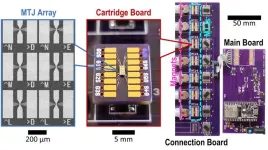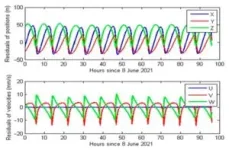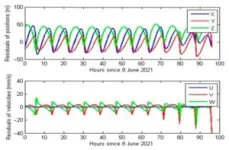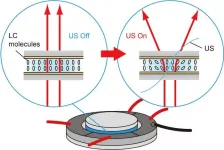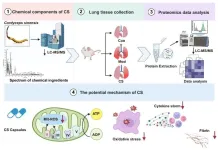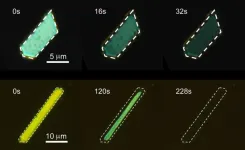(Press-News.org) MINNEAPOLIS / ST. PAUL (07/25/2024) — Engineering researchers at the University of Minnesota Twin Cities have demonstrated a state-of-the-art hardware device that could reduce energy consumption for artificial intelligent (AI) computing applications by a factor of at least 1,000.
The research is published in npj Unconventional Computing, a peer-reviewed scientific journal published by Nature. The researchers have multiple patents on the technology used in the device.
With the growing demand of AI applications, researchers have been looking at ways to create a more energy efficient process, while keeping performance high and costs low. Commonly, machine or artificial intelligence processes transfer data between both logic (where information is processed within a system) and memory (where the data is stored), consuming a large amount of power and energy.
A team of researchers in the University of Minnesota College of Science and Engineering demonstrated a new model where the data never leaves the memory, called computational random-access memory (CRAM).
“This work is the first experimental demonstration of CRAM, where the data can be processed entirely within the memory array without the need to leave the grid where a computer stores information,” said Yang Lv, a University of Minnesota Department of Electrical and Computer Engineering postdoctoral researcher and first author of the paper.
The International Energy Agency (IEA) issued a global energy use forecast in March of 2024, forecasting that energy consumption for AI is likely to double from 460 terawatt-hours (TWh) in 2022 to 1,000 TWh in 2026. This is roughly equivalent to the electricity consumption of the entire country of Japan.
According to the new paper’s authors, a CRAM-based machine learning inference accelerator is estimated to achieve an improvement on the order of 1,000. Another example showed an energy savings of 2,500 and 1,700 times compared to traditional methods.
This research has been more than two decades in the making,
“Our initial concept to use memory cells directly for computing 20 years ago was considered crazy” said Jian-Ping Wang, the senior author on the paper and a Distinguished McKnight Professor and Robert F. Hartmann Chair in the Department of Electrical and Computer Engineering at the University of Minnesota.
“With an evolving group of students since 2003 and a true interdisciplinary faculty team built at the University of Minnesota—from physics, materials science and engineering, computer science and engineering, to modeling and benchmarking, and hardware creation—we were able to obtain positive results and now have demonstrated that this kind of technology is feasible and is ready to be incorporated into technology,” Wang said.
This research is part of a coherent and long-standing effort building upon Wang’s and his collaborators’ groundbreaking, patented research into Magnetic Tunnel Junctions (MTJs) devices, which are nanostructured devices used to improve hard drives, sensors, and other microelectronics systems, including Magnetic Random Access Memory (MRAM), which has been used in embedded systems such as microcontrollers and smart watches.
The CRAM architecture enables the true computation in and by memory and breaks down the wall between the computation and memory as the bottleneck in traditional von Neumann architecture, a theoretical design for a stored program computer that serves as the basis for almost all modern computers.
“As an extremely energy-efficient digital based in-memory computing substrate, CRAM is very flexible in that computation can be performed in any location in the memory array. Accordingly, we can reconfigure CRAM to best match the performance needs of a diverse set of AI algorithms,” said Ulya Karpuzcu, an expert on computing architecture, co-author on the paper, and Associate Professor in the Department of Electrical and Computer Engineering at the University of Minnesota. “It is more energy-efficient than traditional building blocks for today’s AI systems.”
CRAM performs computations directly within memory cells, utilizing the array structure efficiently, which eliminates the need for slow and energy-intensive data transfers, Karpuzcu explained.
The most efficient short-term random access memory, or RAM, device uses four or five transistors to code a one or a zero but one MTJ, a spintronic device, can perform the same function at a fraction of the energy, with higher speed, and is resilient to harsh environments. Spintronic devices leverage the spin of electrons rather than the electrical charge to store data, providing a more efficient alternative to traditional transistor-based chips.
Currently, the team has been planning to work with semiconductor industry leaders, including those in Minnesota, to provide large scale demonstrations and produce the hardware to advance AI functionality.
In addition to Lv, Wang, and Karpuzcu, the team included University of Minnesota Department of Electrical and Computer Engineering researchers Robert Bloom and Husrev Cilasun; Distinguished McKnight Professor and Robert and Marjorie Henle Chair Sachin Sapatnekar; and former postdoctoral researchers Brandon Zink, Zamshed Chowdhury, and Salonik Resch; along with researchers from Arizona University: Pravin Khanal, Ali Habiboglu, and Professor Weigang Wang
This work was supported by grants from the U.S. Defense Advanced Research Projects Agency (DARPA), National Institute of Standards and Technology (NIST), the National Science Foundation (NSF), and Cisco Inc. Research including nanodevice patterning was conducted in collaboration with the Minnesota Nano Center and simulation/calculation work was done with the Minnesota Supercomputing Institute at the University of Minnesota.
To read the entire research paper entitled, “Experimental demonstration of magnetic tunnel junction-based computational random-access memory,” visit the npj Unconventional Computing website.
END
Researchers develop state-of-the-art device to make artificial intelligence more energy efficient
Energy consumption from artificial intelligence could be reduced by a factor of at least 1,000 with this device
2024-07-26
ELSE PRESS RELEASES FROM THIS DATE:
The Texas Heart Institute provides BiVACOR® Total Artificial Heart Patient update
2024-07-26
Houston, Texas, July 26, 2024 – The Texas Heart Institute (THI), a globally renowned cardiovascular health center, and BiVACOR®, a leading clinical-stage medical device company, are pleased to provide an update on the condition of the first patient to receive the BiVACOR Total Artificial Heart (TAH) implant on July 9, as part of the U.S. Food and Drug Administration (FDA) Early Feasibility Study (EFS). On July 17, eight days following the BiVACOR TAH implant, a donor heart became available and was transplanted into the ...
The ancestor of all modern birds probably had iridescent feathers
2024-07-26
The color palette of the birds you see out your window depend on where you live. If you’re far from the Equator, most birds tend to have drab colors, but the closer you are to the tropics, you’ll probably see more and more colorful feathers. Scientists have long been puzzled about why there are more brilliantly-colored birds in the tropics than in other places, and they’ve also wondered how those brightly-colored birds got there in the first place: that is, if those colorful feathers evolved in the tropics, or if tropical birds have colorful ancestors that came to the region from somewhere else. In a new study published ...
A rare form of ice at the center of a cool new discovery about how water droplets freeze
2024-07-26
Tokyo, Japan – Ice is far more complicated than most of us realize, with over 20 different varieties known to science, forming under various combinations of pressure and temperature. The kind we use to chill our drinks is known as ice I, and it’s one of the few forms of ice that exist naturally on Earth. Researchers from Japan have recently discovered another type of ice: ice 0, an unusual form of ice that can seed the formation of ice crystals in supercooled water.
The formation of ice near the surface ...
Embargoed - Researchers devise novel solution to preventing relapse after CAR T-cell therapy
2024-07-26
Lack of persistence of CAR T cells is major limiting step in CAR T-cell therapy
Made by fusing an immune-stimulatory molecule to a protein from cancer cells, the therapy selectively targets CAR T cells and enhances their functionality and persistence in the body, extending their attack on cancer.
The therapy, called CAR-Enhancer (CAR-E), also causes CAR T cells to retain a memory of the cancer, allowing them to mount another attack if cancer recurs
BOSTON – Even as they have revolutionized the treatment of certain forms of cancer, CAR T-cell therapies ...
Lampreys possess a ‘jaw-dropping’ evolutionary origin
2024-07-26
EVANSTON, Ill. --- One of just two vertebrates without a jaw, sea lampreys that are wreaking havoc in Midwestern fisheries are simultaneously helping scientists understand the origins of two important stem cells that drove the evolution of vertebrates.
Northwestern University biologists have pinpointed when the gene network that regulates these stem cells may have evolved and gained insights into what might be responsible for lampreys’ missing mandibles.
The two cell types — pluripotent blastula cells (or embryonic stem cells) and neural crest cells — are both “pluripotent,” ...
"Just like your mother?" Maternal and paternal X-chromosomes show skewed distribution in different organs and tissues.
2024-07-26
A new study published in Nature Genetics by the Lymphoid Development Group at the MRC Laboratory of Medical Sciences has reveals that the contribution of cells expressing maternal or paternal X chromosomes can be selectively skewed in different parts of the body. The study leverages human data from the 1000 Genomes Project combined with mouse models of human X chromosome-linked DNA sequence variation to advance our fundamental understanding of development in biologically female individuals who have two X chromosomes.
Until now, it was thought that the usage of maternal and paternal X-chromosomes was similar throughout the body. The ...
Conflicting health advice from agencies drives confusion, study finds, but doctors remain most trusted
2024-07-26
Distrust of health experts and credulity towards misinformation can kill. For example, during the Covid-19 crisis, high-profile health experts received death threats while misinformation went viral on social media. And already long before the pandemic, easily preventable but potentially serious diseases had been making a comeback around the world due to vaccine hesitancy – often powered by conspiracy theories.
But what feeds this lack in trust in reliable sources of health information? Can it perhaps be mitigated? Those are the subjects of a new study in Frontiers in Medicine by researchers from the US.
“Here we show that individuals who ...
Towards next-gen indoor lighting: novel tunable ultrasonic liquid crystal light diffuser
2024-07-26
It is no mystery that light is essential to human life. Since the discovery of fire, humans have developed various artificial light sources, such as incandescent lamps, gaslights, discharge lamps, and light-emitting diodes (LEDs). The distribution and intensity of artificial lights indoors are important factors that affect our ability to study and work effectively and influence our physical and mental health. Consequently, modern artificial light sources are designed with these psychological elements to achieve the best aesthetics. ...
Chinese medicinal fungus shows promise in treating idiopathic pulmonary fibrosis
2024-07-26
A recent study from China has reported that Cordyceps sinensis (CS), a traditional Chinese medicinal fungus, can ameliorate idiopathic pulmonary fibrosis (IPF) in mice by inhibiting mitochondrion-mediated oxidative stress. The research, conducted by a team led by Huan Tang and Jigang Wang from the Institute of Chinese Materia Medica at the China Academy of Chinese Medical Sciences, was published in Wiley's MedComm-Future Medicine.
Idiopathic pulmonary fibrosis is a chronic and progressive lung disease characterized by a decline in lung function, ultimately leading to respiratory failure and a significantly reduced quality of life for patients. With a median ...
Shining light on similar crystals reveals photoreactions can differ
2024-07-26
A rose by any other name is a rose, but what of a crystal? Osaka Metropolitan University-led researchers have found that single crystals of four anthracene derivatives with different substituents react differently when irradiated with light, perhaps holding clues to how we can use such materials in functional ways.
Graduate student Sogo Kataoka, Dr. Daichi Kitagawa, a lecturer, and Professor Seiya Kobatake of the Graduate School of Engineering and colleagues compared the photoreactions of the single crystals when the entire anthracene crystal was irradiated with light.
For two ...
LAST 30 PRESS RELEASES:
Numbers in our sights affect how we perceive space
SIMJ announces global collaborative book project in commemoration of its 75th anniversary
Air pollution exposure and birth weight
Obstructive sleep apnea risk and mental health conditions among older adults
How talking slows eye movements behind the wheel
The Ceramic Society of Japan’s Oxoate Ceramics Research Association launches new international book project
Heart-brain connection: international study reveals the role of the vagus nerve in keeping the heart young
Researchers identify Rb1 as a predictive biomarker for a new therapeutic strategy in some breast cancers
Survey reveals ethical gaps slowing AI adoption in pediatric surgery
Stimulant ADHD medications work differently than thought
AI overestimates how smart people are, according to HSE economists
HSE researchers create genome-wide map of quadruplexes
Scientists boost cell "powerhouses" to burn more calories
Automatic label checking: The missing step in making reliable medical AI
Low daily alcohol intake linked to 50% heightened mouth cancer risk in India
American Meteorological Society announces Rick Spinrad as 2026 President-Elect
Biomass-based carbon capture spotlighted in newly released global climate webinar recording
Illuminating invisible nano pollutants: advanced bioimaging tracks the full journey of emerging nanoscale contaminants in living systems
How does age affect recovery from spinal cord injury?
Novel AI tool offers prognosis for patients with head and neck cancer
Fathers’ microplastic exposure tied to their children’s metabolic problems
Research validates laboratory model for studying high-grade serous ovarian cancer
SIR 2026 delivers transformative breakthroughs in minimally invasive medicine to improve patient care
Stem Cell Reports most downloaded papers of 2025 highlight the breadth and impact of stem cell research
Oxford-led study estimates NHS spends around 3% of its primary and secondary care budget on the health impacts of heat and cold in England
A researcher’s long quest leads to a smart composite breakthrough
Urban wild bees act as “microbial sensors” of city health.
New study finds where you live affects recovery after a hip fracture
Forecasting the impact of fully automated vehicle adoption on US road traffic injuries
Alcohol-related hospitalizations from 2016 to 2022
[Press-News.org] Researchers develop state-of-the-art device to make artificial intelligence more energy efficientEnergy consumption from artificial intelligence could be reduced by a factor of at least 1,000 with this device
